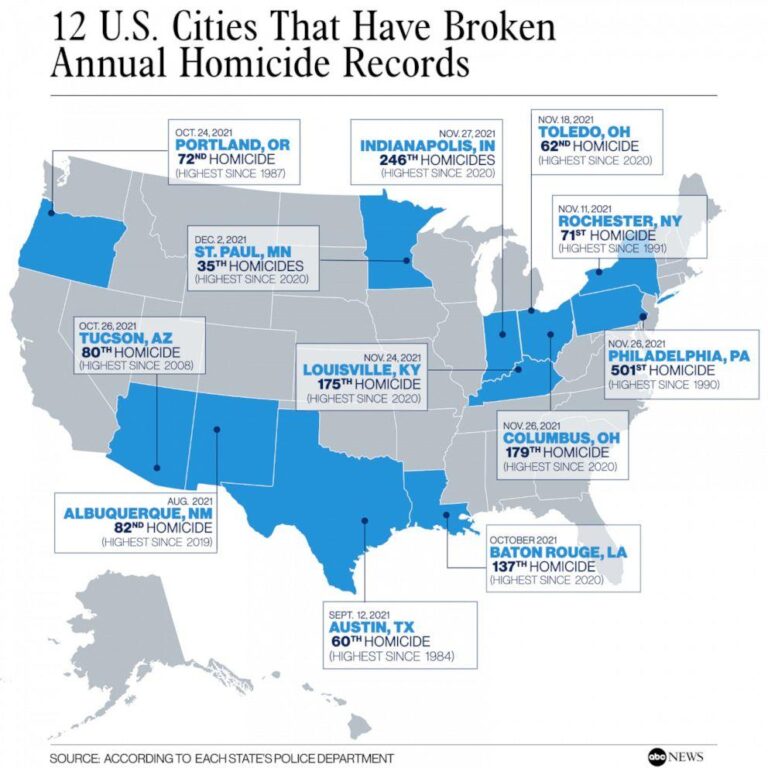Homicide and most other violent crimes in U.S. cities have declined to levels below those recorded before the COVID-19 pandemic, according to a new analysis by the Council on Criminal Justice. The report highlights a notable shift in urban crime trends after a surge in violence during the early years of the pandemic. This development offers important insights into the evolving landscape of public safety and law enforcement efforts across the country.
Homicide Rates Show Variability Across Major U.S. Cities Since Pandemic
Since the onset of the COVID-19 pandemic, homicide rates across major U.S. cities have displayed notable variability, reflecting complex socio-economic factors at play. While some metropolitan areas reported significant spikes during the early months of the pandemic, others experienced declines or stabilization in violent crime numbers as communities adapted to new norms. These fluctuations highlight the importance of localized policy interventions and resource allocation tailored to each city’s unique challenges.
Key factors influencing these trends include:
- Economic disruptions and unemployment rates
- Changes in policing strategies and community engagement
- Shifts in social behavior due to lockdowns and mobility restrictions
- Variations in access to social services and mental health support
| City | 2020 Homicide Rate (per 100,000) | 2023 Homicide Rate (per 100,000) | Trend |
|---|---|---|---|
| Chicago | 29.3 | 24.7 | Ōåō Decrease |
| Los Angeles | 8.2 | 10.5 | Ōåæ Increase |
| New York City | 5.6 | 3.4 | Ōåō Decrease |
| Houston | 11.1 | 12.3 | Ōåæ Increase |
Decline in Assault and Robbery Suggests Shifts in Urban Crime Patterns
The latest data reveal a noteworthy reduction in assault and robbery incidents across major U.S. urban centers, signaling potential changes in the underlying dynamics of city crime. Experts suggest that this decline could be attributed to a combination of enhanced community policing strategies, technological surveillance advancements, and shifting social behaviors post-pandemic. This transformation points to a broader evolution in how violent crimes manifest and are addressed within metropolitan environments.
Understanding these trends involves examining several factors that likely contribute to these positive shifts, including:
- Increased deployment of predictive policing tools, enabling faster law enforcement responses and deterrence.
- Community engagement initiatives fostering stronger neighborhood collaboration with authorities.
- Economic recovery efforts aimed at addressing root causes of criminal activity, such as unemployment and housing instability.
| Crime Type | 2019 Rate | 2023 Rate | % Change |
|---|---|---|---|
| Assault | 45 per 100K | 30 per 100K | -33% |
| Robbery | 20 per 100K | 13 per 100K | -35% |
Experts Analyze Contributing Factors Behind Post-Pandemic Crime Trends
Leading criminologists emphasize several overlapping factors that appear to have reshaped crime trajectories in urban centers across the United States since the onset of the pandemic. Among the most cited elements are the sustained increase in community policing efforts, evolving social service frameworks providing better support to at-risk populations, and significant changes in routine daily activities due to remote work and altered social gatherings. Experts underline that these combined shifts created a landscape less conducive to certain types of violent crime, especially homicides.
Key contributing aspects include:
- Enhanced neighborhood surveillance through technology and community engagement, deterring potential offenders.
- Expanded access to mental health services mitigating crises that could escalate to violence.
- Changes in public space usage reducing opportunities for traditional crime patterns.
| Factor | Impact on Crime | Evidence |
|---|---|---|
| Community Policing | Reduced violent encounters | City-level crime reports |
| Mental Health Outreach | Fewer crisis-related incidents | Increased service utilization stats |
| Social Behavior Shifts | Less public congregation reduces crime hotspots | Mobility and activity data |
Policy Recommendations Focus on Sustaining Violent Crime Reductions
To ensure that the downward trend in violent crime, particularly homicides, continues, experts emphasize the need for targeted community investments paired with enhanced law enforcement strategies. Priority recommendations include increasing funding for violence prevention programs, expanding mental health services, and improving data-sharing among agencies to identify and address hotspots swiftly. Furthermore, collaboration with community leaders can foster trust and encourage public cooperation, which is crucial for maintaining long-term safety improvements.
Policymakers are also urged to consider structural reforms that address underlying social inequities contributing to violence. Key focus areas involve:
- Affordable housing initiatives that stabilize neighborhoods.
- Education and employment opportunities for at-risk populations.
- Crisis intervention units to reduce unnecessary law enforcement escalation.
Below is a summary of priority policy actions currently being advocated by criminal justice organizations:
| Policy Area | Recommended Action | Expected Outcome |
|---|---|---|
| Community Investment | Increase funding for youth programs | Reduced youth involvement in violence |
| Law Enforcement | Expand data-driven policing | Faster response to crime trends |
| Mental Health | Integrate crisis teams with police | Fewer violent confrontations |
In Summary
As U.S. cities continue to navigate the complex landscape of public safety, recent data reveals a notable decline in homicide and most other violent crimes, falling below pre-pandemic levels. This trend offers a cautiously optimistic outlook for law enforcement agencies and communities alike, highlighting the potential impact of targeted interventions and policy reforms. However, experts emphasize the need for ongoing vigilance and sustained efforts to address the underlying factors contributing to violence. The Council on Criminal JusticeŌĆÖs findings serve as a critical benchmark for policymakers striving to foster safer urban environments in the post-pandemic era.




